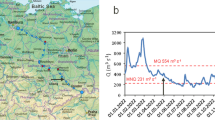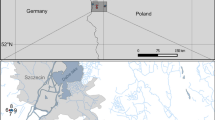Abstract
The phytoplankton community of river–floodplain ecosystems shows significant temporal fluctuations in response to hydrosedimentological regime. The aim of our study was analyze the effect of the hydrosedimentological regime of the Paraná and Ivinhema Rivers on the interannual variation in the composition, biovolume and functional groups of phytoplankton in an isolated floodplain lake (Ventura Lagoon) of the Ivinhema River State Park, located in the Upper Paraná River floodplain (Mato Grosso do Sul State, Brazil). Samples of phytoplankton were taken at the sub-surface of the pelagic zone of the lake from February 2000 to December 2005. A total of 132 taxa were recorded, and the species that represented greater contributions to the phytoplankton biovolume were grouped into five functional groups (FG) (H1, H2, M, MP and Y). The distribution of the FGs were linked to the high and low water periods in Ventura lagoon. Functional groups MP and Y were the highest contributors to the phytoplankton biovolume during the high water periods, whereas FGs H1, H2 and M contributed more during the low water periods. The FGs were also useful for the interannual characterization of Ventura Lagoon by taking the changes caused by climatological factors into account. There was a strong dominance of Cyanobacteria (H2 and M) in 2000 and 2001 (La Niña periods) coincident with low precipitation and low hydrometric levels of the Paraná and Ivinhema Rivers and, consequently, lower water depths of Ventura Lagoon. In 2002, 2003, 2004 and 2005 (El Niño periods), when higher precipitation, higher hydrometric levels, higher discharge of the Paraná and Ivinhema Rivers and an increased depth of Ventura Lagoon were observed, Cyanobacteria (H1, H2 and M) were dominant, followed by Bacillariophyceae (MP) and Cryptophyceae (Y). These results reported here corroborate the utility of using FGs as indicators of interannual and seasonal variability in floodplain lakes.





Similar content being viewed by others
References
American Public Health Association (APHA), 1995. Standard Methods for the Examination of Water and Wastewater, 19th ed. APHA, Washington D.C.
Cole, G. A., 1994. Textbook of Limnology. Waveland Press, Lake Zurich, IL.
Comunello, E., E. E. Souza Filho, P. C. Rocha & M. R. Nanni, 2003. Dinâmica de inundação de áreas sazonalmente alagáveis na planície aluvial do alto rio Paraná: estudo preliminar. Anais XI SBSR. INPE, Belo Horizonte: 2459–2466.
Edler, L., 1979. Recommendations for Marine Biological Studies in the Baltic Sea: Phytoplankton and Chlorophyll. UNESCO Working Group 11: Baltic Marine Biologists. UNESCO, Paris.
Garcia de Emiliani, M. O., 1993. Seasonal succession of phytoplankton in a lake of the Paraná River floodplain. Hydrobiologia 264: 101–114.
Garcia de Emiliani, M. O. & M. Devercelli, 2003. Influencia del fenómeno “El Niño” sobre el transporte y la estructura del fitoplâncton em el cauce principal del río Paraná Médio, Argentina. Boletin de la Sociedad Argentina de Botánica 38: 29–38.
Golterman, H. L., R. S. Clymo & M. A. M. Ohstad, 1978. Methods for Physical and Chemical Analysis of Freshwater. Blackwell Scientific, Oxford.
Guerra, G. L., D. P. Costa, V. V. Silva & A. M. M. Ferreira, 2004. Identificação de padrões de uso e cobertura do solo através da aplicação de geotecnologias: o caso do Parque Estadual das Várzeas do Rio Ivinhema. MSc thesis. Available at: http://igeo.uerj.br/VICBG-2004/Eixo2/E2_085.htm.
Harris, P. H. & G. Baxter, 1996. Interannual variability in phytoplankton biomass and species composition in a subtropical reservoir. Freshwater Biology 35: 545–560.
Horne, A. J., J. E. Dillard, D. K. Fujita & C. R. Goldman, 1972. Nitrogen fixation in clear lake. California. II. Synoptic studies on the autumn Anabaena bloom. Limnology and Oceanography 17: 693–703.
Huszar, V. L. M. & C. S. Reynolds, 1997. Phytoplankton periodicity and sequences of dominance in an Amazonian flood-plain lake (Lago Batata. Pará. Brazil): Responses to gradual environmental change. Hydrobiologia 346: 169–181.
Jansson, M., P. Blomqvist, A. Jonsson & A. K. Bergström, 1996. Nutrient limitation of bacterioplankton, autotrophic and mixotrophic phytoplankton, and heterotrophic nanoflagellates in Lake Örträsket. Limnology and Oceanography 41: 1552–1559.
Jones, R. I., 2000. Mixotrophy in planktonic protists: An overview. Freshwater Biology 45: 219–226.
Junk, W. J., P. B. Bayley & R. E. Sparks, 1989. The flood pulse concept in river-floodplain systems. Canadian Special Publication of Fisheries and Aquatic Sciences 106: 110–127.
Klaveness, D., 1988. Ecology of the Cryptomonadida: A first review. In Sandgren, C. (ed.), Growth and Reproductive Strategies of Freshwater Phytoplankton. Cambridge University Press, Cambridge: 105–133.
Komárek, J. & K. Anagnostidis, 1996. Cyanoprokaryota. 1. Teil Chroococcales. In Ettl, H., G. Gärtner, H. Heynig & D. Möllenhauer (eds), Sübwasserflora von Mitteleuropa. Gustav Fischer Verlag, Jena: 1–548.
Koroleff, K., 1978. Determination of ammonia. In Grasshoff, K. & E. Kremling (eds), Methods of Seawater Analysis. Verlag Chemie, Winhein.
Kruk, C., N. Mazzeo, G. Lacerot & C. S. Reynolds, 2002. Classification schemes for phytoplankton: A local validation of functional approach to the analysis of species temporal replacement. Journal of Plankton Research 24: 901–912.
Lewis, W. M., S. K. Hamilton, M. A. Lasi, M. Rodrígues & J. F. Saunders, 2000. Ecological determinism on the Orinoco floodplain. Bioscience 50: 681–692.
Lind, O. T., T. T. Terrell & B. L. Kimmel, 1993. Problems in reservoir trophic-state classification and implications for reservoir management. In Straskraba, M., J. G. Tundisi & A. Ducan (eds), Comparative Reservoir Limnology and Water Quality Management. Kluwer, Dordrecht: 57–67.
McCune, B. & M. J. Mefford, 1999. Pc-Ord. Multivariate Analysis of Ecological Data, Version 4.0. Mjm Software Design, Gleneden Beach, OR.
McPhaden, M. J., S. E. Zebiak & M. H. Glantz, 2006. ENSO as an integrating concept in earth science. Science 314: 1740–1745.
Melo, S. & V. L. M. Huszar, 2000. Phytoplankton in an Amazonian flood-plain lake (Lago Batata. Brasil): diel variation and species strategies. Journal of Plankton Research 22: 63–76.
Nabout, J. C., I. S. Nogueira & L. G. Oliveira, 2006. Phytoplankton community of floodplain lakes of the Araguaia River, Brazil, in the rainy and dry seasons. Journal of Plankton Research 28: 181–193.
Neiff, J. J., 1990. Ideas para la interpretacion ecológica del Paraná. Interciencia 15(6): 424–441.
Padisák, J., G. Borics, I. Grigorszky & E. Soroczki-Pinter, 2006. Use of phytoplankton assemblages for monitoring ecological status of lakes the Water Framework Directive: The assemblage index. Hydrobiologia 553: 1–14.
de Reviers, B., 2003. Biologie et phylogénie des algues. tome 2. Éditions Berlin, Paris.
Reynolds, C. S., 1997. Vegetation Process in the Pelagic: A Model for Ecosystem Theory. Ecology Institute, Oldendorf.
Reynolds, C. S., V. L. M. Huszar, C. Kruk, L. Naselli-Flores & S. Melo, 2002. Towards a functional classification of the freshwater phytoplankton. Journal of Plankton Research 24: 417–428.
Rocha, P. C., 2002. Dinâmica dos canais no sistema rio-planície fluvial do alto rio Paraná nas proximidades de Porto Rico-PR. PhD thesis. Universidade Estadual de Maringá, Maringá.
Salmaso, N. & J. Padisák, 2007. Morpho-Functional Groups and phytoplankton development in two deep lakes (Lake Garda, Italy and Lake Stechlin, Germany). Hydrobiologia 578: 97–112.
Seeliger, U., C. Cordazzo & F. Barbosa, 2002. Os sites e o programa brasileiro de pesquisas ecológicas de longa duração. MCT/CNPq. Programa PELD, Belo Horizonte.
Souza Filho, E. E. & J. C. Stevaux, 2004. Geology and geomorphology of the Baía-Curutuba-Ivinheima river complex. In Thomaz, S. M., A. A. Agostinho & N. S. Hahn (eds), The Upper Paraná River and its floodplain: Physical Aspects, Ecology and Conservation. Backhuys, Leiden: 1–29.
Statsoft Inc., 2005. Statistica (data analysis software system) version 7.1. Available at: www.statisoft.inc.
Ter Braak, C. J. F., 1986. Canonical correspondence analysis: A new eigenvector technique for multivariate direct gradient analysis. Ecology 67: 1167–1179.
Thomaz, S. M., T. A. Pagioro, L. M. Bini, M. C. Roberto & R. R. A. Rocha, 2004. Limnological characterization of the aquatic environments and the influence of hydrometric levels. In Thomaz, S. M., A. A. Agostinho & N. S. Hahn (eds), The Upper Paraná River and its floodplain: Physical Aspects, Ecology and Conservation. Backhuys, Leiden: 75–102.
Townsend, S. A., 2006. Hydraulic phases, persistent stratification and phytoplankton in a tropical floodplain lake (Mary River. Northern Australia). Hydrobiologia 556: 163–179.
Train, S. & L. C. Rodrigues, 1998. Temporal fluctuations of the phytoplankton community of the Baía River, in the Upper Paraná River floodplain. Mato Grosso do Sul. Brazil. Hydrobiologia 361: 125–134.
Train, S. & L. C. Rodrigues, 2004. Phytoplankton assemblages. In Thomaz, S. M., A. A. Agostinho & N. S. Hahn (eds), The Upper Paraná River floodplain: Physical Aspects, Ecology and Conservation. Backhuys, Netherlands: 103–124.
Train, S., M. D. Oliveira & M. T. Quevedo, 2000. Dinâmica sazonal da comunidade fitoplanctônica de um canal lateral (Canal Cortado) do alto rio Paraná (PR. Brasil). Acta Scientiarum 22: 389–395.
Train, S., L. C. Rodrigues, V. M. Bovo, P. A. F. Borges & B. M. Pivato, 2004. Phytoplankton composition and biomass in environments of the Upper Paraná River. In Agostinho, A. A., L. Rodrigues, L. C. Gomes, S. M. Thomaz & L. E. Mira (eds), Structure and Functioning of the Paraná River and its Floodplain. EDUEM, Maringá: 63–74.
Universidade Estadual de Maringá, NUPELIA/PELD, 2005. A planície alagável do alto rio Paraná: estrutura e processos ambientais. Maringá.
Utermöhl, H., 1958. Zur Vervollkommnung der quantitativen Phytoplankton-Methodik. Mitteilungen internationale Vereinigung für theoretische und angewandte Limnologie 9: 1–38.
Ward, J. V. & K. Tockner, 2001. Biodiversity: Towards a unifying theme for river ecology. Freshwater Biology 46: 807–819.
Westwood, K. J. & G. G. Ganf, 2004. Effect of mixing patterns and light dose on growth of Anabaena circinalis in a turbid, lowland river. River Research Application 20: 115–126.
Wetzel, R. G. & G. E. Likens, 2000. Limnological Analysis. Springer, New York.
Zalocar de Domitrovic, Y., 2003. Effect of fluctuations in water level on phytoplankton development in three lakes of the Paraná River floodplain (Argentina). Hydrobiologia 510: 175–193.
Zagatto, E. A. G., A. O. Jacintho, B. F. Reis, F. J. Kung, R. Bergamin-Filho, L. C. R. Pessenda, J. Mortatti & M. F. Giné, 1981. Manual de análises de plantas e águas, empregando sistemas de injeção em fluxo. CENA, USP, Piracicaba.
Acknowledgements
The authors are grateful to the Núcleo de Pesquisas em Limnologia, Ictiologia e Aqüicultura (Nupélia) at Universidade Estadual de Maringá for logistic support; to researchers of the Limnology Laboratory of Nupélia for determining water abiotic factors; to CNPq/PELD for financial support; to CAPES for a scholarship granted to the first author. Special thanks are due to the two anonymous reviewers whose suggestions helped to improve the original submission.
Author information
Authors and Affiliations
Corresponding author
Additional information
Handling editor: J. Padisak
Rights and permissions
About this article
Cite this article
Bovo-Scomparin, V.M., Train, S. Long-term variability of the phytoplankton community in an isolated floodplain lake of the Ivinhema River State Park, Brazil. Hydrobiologia 610, 331–344 (2008). https://doi.org/10.1007/s10750-008-9448-3
Received:
Revised:
Accepted:
Published:
Issue Date:
DOI: https://doi.org/10.1007/s10750-008-9448-3




